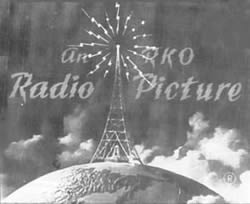Studio Style
 Although each studio produced many different kinds of films, each was known for a particular style and for particular actors.
Although each studio produced many different kinds of films, each was known for a particular style and for particular actors.
The Big Five
MGM was the largest and most powerful. L.B. Mayer and Irving Thalberg kept tight control and were concerned with developing an extensive roster of stars. Their slogan was: "more stars than there are in heaven" Mayer positioned the studio as expressing American values and wholesomeness. It's interesting (and I think important) to note that Hollywood was the great conveyers of American Values. However, the values portrayed were conditioned by immigrant dreams of what American values should be and not necessarily reflective of what American values were when the films were produced. Great MGM stars included Joan Crawford, Clark Gable, Greta Garbow, and Judy Garland.
Paramount, led by Adolph Zukor and Barney Balaban, became known for sophistication and cultivated a "European" sensibility. It was a much looser organization and allowed a broader range of styles and greater sexuality. It wanted to project an image of tasteful elegance but it also included great stars such as Mae West, W. C. Fields, and the Marx Brothers.
Warner Brothers, led mostly by Jack, Harry, and Sam Warner, and sometimes David Zanuck, was less wealthy than either MGM or Paramount had lower production values (less costly costumes and sets and so forth) but focused on tight, cleverly written dialogue, the depiction of social problems, and gritty realism. Some of the best known Warner stars are James Cagney, Humphy Bogart, Bette Davis, and Ruby Keeler. WB, unlike either MGM or Paramount was openly supportive of FDR and the New Deal and openly opposed to the rise of Hitler. Of course, WB also had the best cartoon division.
20th Century Fox, led mostly by David Zanuck and Joseph Schenck, focused on historical films and adventure films. Fox wanted to build a populist image. It developed a reputation for old-fashioned-middle-class values and movies that provided reassuring entertainment rather than challenging their viewers. However, particularly in the late 1930s and 1940s it also made some very powerful films, particularly Grapes of Wrath. Fox's biggest stars were Will Rogers and Shirley Temple. Others included Don Ameche, Alice Faye and Tyrone Power.
RKO was the smallest of the five. You'll recall that it was a descendant of the Keith-Orpheum vaudeville circuit. It was the result of a collaboration between David Sarnoff, the head of RCA, Joseph Kennedy, from the Film Booking Offices of America (and father of JFK), and a chain of movie theaters. RKO was the most experimental of the five. Probably its most famous productions were the dance movies of Fred Astaire and Ginger Rogers (Astair and Rogers made nine of their ten movies with RKO). King Kong was another RKO production.
The Little Three
The little three studios were smaller and poorer than the big five. Critically, none of them owned theater chains... they were more like today's studios.
Universal, controlled by Carl Lammle, was known primarily for its horror movies, particularly The Hunchback of Notre Dame. Other Universal horror fims included Dracula, Freaks, Frankenstien, The Mummy.... Lon Chaney and Boris Karloff were among its biggest stars. Universal did do other things beside horror. It was the home of Abbott and Costello.
Columbia Pictures was run by the notoriously short tempered Harry Cohn and his brother Jack. It was probably the most dictatorial of the studios...even more than MGM. Its productions were largely low budget movies but it took the lead in making movies of popular comic strips (most current Marvel pics are 20th Century Fox, but Columbia still owns the rights to Spiderman and Ghost Rider). Columbia's most famous director was Frank Capra (It happened one night, It's a Wonderful Life, etc.). Clark Gable, Claudette Colbert, Jimmy Stewart, Rita Hayworth, and Rosalind Russell were all Columbia stars. Columbia also produced a lot of shorts. It was also the home of The Three Stooges.
Finally United Artists. UA was a company founded by movie stars who became powerful enough to control movie production. The original United Artists included Mary Pickford, Douglas Fairbanks, Charlie Chaplin and D. W. Griffith. A large variety of extremely important movies were released by UA including Charlie Chaplin's works, the first two Hitchcock movies made in the US, and films like Scarface, I Cover the Waterfront, Last of the Mohicans, A Star is Born, Of Mice and Men, and many others. UA probably had the highest percentage of films nominated for Best Picture of any studio in the first half of the 20th century. Because it was a union of convenience among directors and stars with very different ideas, there was no United Artists style.